
Discovering the Marquesas Islands
The Marquesas Islands are located in the far northeast of French Polynesia, which includes the Society Islands (Tahiti, Moorea, Raiatea, Bora Bora, Taha'a, etc.), the Tuamotu (Rangiroa, Tikehau, Fakarava, etc.), the Austral Islands (Rurutu, Tubuai, etc.) and the Gambier (Mangareva, Taravai, etc.).
Your departure from Papeete marks the beginning of an unforgettable journey. A quick flight or a few nights aboard a cruise ship will take you to this remote archipelago.
The Marquesas Islands (“Îles Marquises” in French) consists of 12 islands, six of which are inhabited. The islands are 1,500 km from Papeete, Tahiti and nearly 1,800 km from Bora Bora. Visiting these islands is a different kind of adventure than visiting the unique and memorable Marquesas.
A warning comes over the speaker from the pilot of our plane that took off from Tahiti three hours ago: “We’ll arrive at Nuku Hiva in a few minutes and will experience some turbulence before landing.”
Some trips are like no other. Get ready for an adventure full of excitement and discovery. The Marquesas awaits you!
The Marquesas Islands, reminiscent of a pilgrimage
This mysterious and charming archipelago promises a journey filled with nature and culture. Here, you will find the mana (spiritual force) characteristic of islands such as Raiatea, the soothing calm of the Tuamotu Islands such as Fakarava or Tikehau, and the deep connection to the ancestral culture that animates all Polynesians. However, this archipelago is unlike any other. It is the ideal destination for a family vacation, a honeymoon or simply for an adventure in a truly unique location.
The journey begins here. Nuku Hiva is one of the three airports in the Marquesas Islands, along with Ua Huka and Hiva Oa.
It was a bumpy arrival. But the ATR 72 made it through without a problem and landed at the Nuku A Taha airport, also known as Deserted Land. The name fits. I expected even more pronounced lushness than in the Society Islands—this is a steppe. The sun darts beneath a band of dark clouds. The deserted land is then bathed in sun and rain. We stand there, motionless in the face of this unbelievable beauty. The light just feels different here.
Exploring the Marquesas is not about tourism. The first thing that comes to mind when I think of the Land of Men (Te Henua Enana in Marquesan) is more like a pilgrimage. This is the real name of this archipelago. The more commonly known name, Marquesas, was given by the Spaniard Álvaro de Mendaña in 1595. But the ancient name, “Land of Men,” has a deeper meaning.
You may think you know French Polynesia because you have visited the main islands of the Society Archipelago. But this is not the case. Although these island groups share common origins, Oceania is home to many cultures, languages (the Tahitian language differs greatly from the Marquesan language), and stories. Meet the people of each island and discover all the secrets of the cultures of Oceania.
The Marquesas, a UNESCO World Heritage Site
The Marquesas Archipelago is a cultural marvel and a jewel of biodiversity. These characteristics have earned it UNESCO World Heritage status.
Its 12 islands and surrounding waters are home to exceptional flora and fauna, a conservation reference in the heart of the Pacific Ocean. The Marquesas Islands' inscription on UNESCO's World Heritage List also celebrates a thousand-year-old culture and a rich history: the Marquesan language, ancestral arts, architectural monuments and traditions inherited from generation to generation all combine to give this archipelago a beautiful and distinctive culture.
Conquering the Polynesian Triangle
The Marquesas Islands are an essential part of Polynesian history. The ancestors of the Marquesans set out to colonize the eastern, northern, and extreme southeast regions of the Pacific Ocean. Their recklessness, faith in their gods, and ignorance of the stars led them to the southwest regions of Hawaii and Aotearoa (New Zealand). To this day, the Hawaiians and Maori still speak a Polynesian language that is similar to Marquesan.
They traveled eastward to the coast of South America, where they brought with them various items like sweet potatoes (kumara) and calabash (hue). Their influence may have even led to a rare mastery of sculpture and the creation of massive statutory art like no other throughout Polynesia.
The Marquesas Islands are so diverse and rich in their landscapes, culture, and archaeological sites that it would be impossible to see everything in one trip. How can anyone choose? Here are six must-see sites.
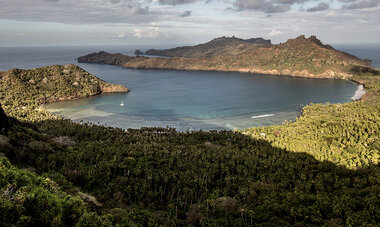
Northern Nuku Hiva
Both Taiohae and Taipivai, located in the south of the island, can be reached from the airport in about 90 minutes via dirt or paved roads. Seeing the Hatihe'u Valley—where Robert Louis Stevenson penned some of his most beautiful works—and the Hikokua archaeological sites takes almost as long. Tekao, the highest peak on the island at 1224 m, stands out among a landscape of valleys, steep cliffs plunging into the sea, and tranquil bays. And then there is this breathtaking canyon like you’d expect to find only in North America on the way from the airport, separating the lush south from the arid north.
Flying over the island with Tahiti Nui Helicopters is a once-in-a-lifetime experience that will give you a new appreciation for the island’s rugged beauty, geology, and isolation—an unparalleled setting that forged the character of the Marquesans.
Natural wonders, such as caves, slender bays, black volcanic and white sand beaches in Anaho Bay, and waterfalls like the 350 m Vaipo waterfall in the Hakaui Valley, complement the major archaeological sites.
Take a day or two to hike through these incredible landscapes and discover an unexpected wonderland.
Nuku Hiva, the main island of the Marquesas, is also the one where you will find the most options for your nights: a villa, local lodge with a suite, or hotel with bungalows, or a family guesthouse in an idyllic setting? The choice is yours! Book the best accommodation for you. You can also enjoy the Marquesas lands by day and spend your nights on board a cruise ship. Whether you're in a luxurious suite or on an open-air deck, the islands always surround you with beauty.
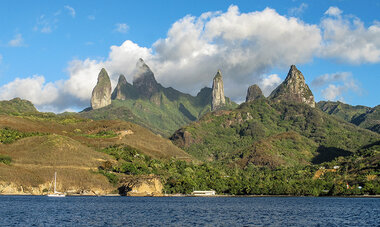
Ua Pou, peaks in the sky
Still in the northern Marquesas, Ua Pou is another of my favorite places thanks to its distinct geography and rich cultural history. The approximately 2,200 inhabitants possess artistic qualities in sculpture, singing, and dancing, as if they were endowed by God. On the island, Marquesan culture permeates every aspect of daily life as well as archaeological sites. As seen in the Hohoi Valley’s flowery pebbles, even nature has joined the artistic fray.
Nestled between two mountains, the altiport at Ua Pou is only accessible via plane. Admire the view and the unique setting while landing. The experience is unforgettable, that’s all I’ll say. What’s more, such an arrival allows you to admire the majestic peaks that seemingly hold up the sky above. The island resembles a cathedral thanks to the twelve pinnacles and numerous pillars that surround the dizzyingly high basalt needles of Mount Oave (1,230 m), Matahenua (1,228 m), and Poutetainui (979 m). It makes you feel small.
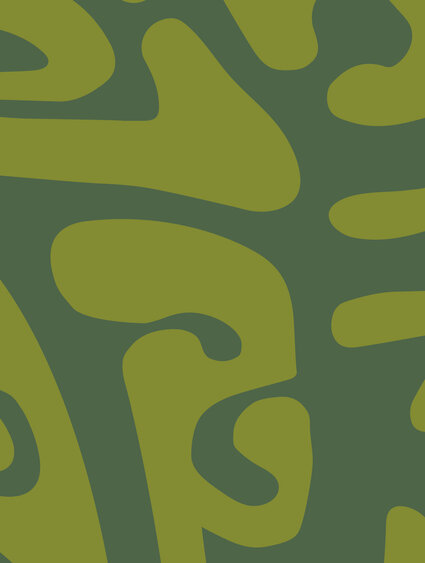
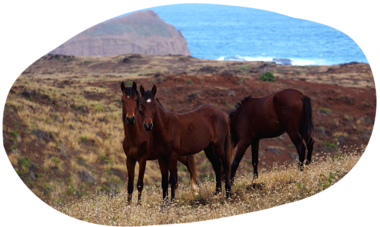
Ua Huka, the wild island
This last island in the north is also the smallest. Six hundred people live on the island, grouped on its southern coast, which is far fewer than the island’s estimated 1,500 wild horses and free-range goats. The island is a tropical garden that preserves its rare archaeological sites and artifacts, such as the red tikis of Meiaute and the exquisite petroglyphs on the Vaikivi plateau.
Book a guesthouse accommodation for a few days to enjoy its authenticity, or discover the island on a cruise to make the most of the unmissable excursions available. Here, each excursion is guided by a passionate local who shares the island's secrets.
Feel free to consult our flight + hotel offers to discover our cruise packages, honeymoon trips or adventure and sports holidays in the heart of the archipelago!
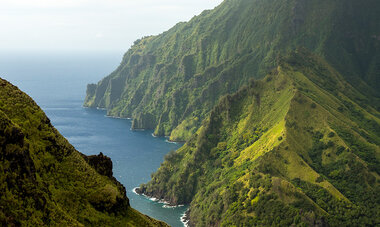
The authentic Fatu Hiva
Make your way to the southernmost region of the Marquesas, the secluded Fatu Hiva. Or should I spell it as Fatuiva? Similar to Mehetia (or Me’etia) in southern Tahiti, the “h” was added by a distracted clerk in the 19th century.
The Baie des Verges (Bay of Virgins), to which the missionaries added an “i” to the name of modesty, is one of the most beautiful in Polynesia, which is saying something considering the stiff competition. Beneath its basalt columns, which resemble stone giants keeping watch over the men, lies the village of Hanavave.
Omoa, located to the southwest, is well known for its enormous fish-shaped petroglyph.
Fatuiva is the island of tapa, a plant bark on which designs are tattooed. In contrast to the umuhei wreaths with their intoxicating scent that women adorned themselves with to seduce warriors, this is a remembrance that endures.
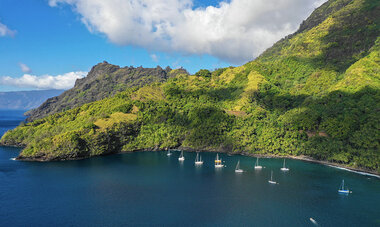
Tahuata, the story lived
On July 27, 1595, a ship without an outrigger—a common feature on Polynesian canoes used for migration, war, or fishing—entered Vaitapu Bay with its white sand and turquoise water. This was quite rare in the Marquesas. The Spanish were the first Europeans in Eastern Polynesia. The name “Las Islas Marquesas Don Garca Hurtado de Mendoza y Canete” was given to this place by lvaro de Mendaa de Neira, commander of the Spanish exploration ships, in honor of the wife of the Viceroy of Peru. Over the years, only the beginning part of the name remained.
Tahuata is also linked to the conflict that occurred in September 1842 between the French and the people who lived in Vaitapu, located in the foothills of Vaitahu Valley. The Marquesans have blended into the landscape, but the cemetery for the French sailors killed at the time can still be visited.
Southwest of here are the petroglyphs of Hanatefau and the ancient, fully paved royal road of the village of Hapatoni. Taking in the island’s pristine beauty also requires a tour. You simply must stay for lunch. It’s the land of lobsters, which can be giant!
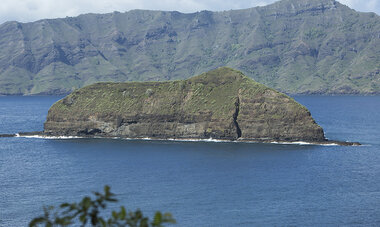
Hiva Oa, the pilgrimage
Let’s finish with Hiva Oa, the largest, most emblematic, most endearing, and arguably most famous of the Marquesan islands. Atuona is the final resting place of Paul Gauguin and Jacques Brel, and for any memories they may have left behind, like Gauguin’s Maison du Jouir.
In addition to being a key location for pre-European dwellings and ceremonial centers, it is an exceptional natural site with bays, beaches, and valleys, including the picturesque Hanaiapa Valley. The Taaoa Valley in Lipona, Puamau, contains Upeke and Pata, which occasionally span several hectares and have platforms (paepae), gathering places (tohua), and places of worship (me’ae).
Hidden within these expansive archaeological complexes and accessible through dense forests bearing valuable timber or enormous fruit trees are petroglyphs (Hatiheu) and the largest tikis in Polynesia, including Takai’i, standing 2.60 m tall. Such a dive into history is seductive. We can see why Brel and Gauguin decided to spend their final years there, with its natural beauty and the warmth and hospitality of its people.
Ready to take your trip to French Polynesia to the next level and visit the Marquesas islands ? Check our travel packages and book your trip now !
The best things to do in the Marquesas Islands
Activities on land
Now you know that the wild beauty of the Marquesas Islands deserves time to be admired. That is why hiking is the best way to discover the archipelago. Hire a guide for a day of hiking or for an e-bike adventure, as the sportsman Mehdi Gabrillargues loves to do. In any case, don't forget to stop regularly: take the time to admire the view, observe the vegetation, and spot the archaeological treasures hidden in the Marquesan valleys.
Between the petroglyphs, the local myths and legends, the traditional dance performances, the gastronomy, the art of tattooing, the craftsmanship and the history of the Marquesas’ most famous visitors - Jacques Brel and Paul Gauguin - there is plenty to do if you want to discover the culture of these mystical places during your trip to French Polynesia. Explore the museums, meet the artists and don't hesitate to hire a guide to learn more about history and culture.
Activities at sea
Although the archipelago is mainly focused on its valleys, you will also find magnificent beaches where you can enjoy a swim while peacefully admiring the view of the Pacific Ocean. Perfect for a relaxing family moment. Discover, for example, Atunoa beach, overlooked by Mount Temetiu, or Hanatekuua beach, a wonderful treat at the end of a hiking trail, both located on Hiva Oa. Other islands such as Nuku Hiva or Tahuata also have beautiful beaches to discover during your stay.
To enjoy the Marquesan sea and landscapes from a different angle, consider a boat trip. Your guide will show you wonderful bays, majestic cliffs and mysterious caves. If you are staying in a guesthouse, ask about available boat trips. Your host may very well become your guide for the day! Many visitors also discover the Marquesas by boat, on a cruise : from the deck, you can admire the untouched landscapes. Plan a few days to truly visit several marquesan islands or combine your journey with the Tuamotu islands.
Finally, choose scuba diving to discover the landscapes hidden beneath the surface. Although the activity is less developed here than on some other Polynesian islands, such as Moorea or Bora Bora, there are a few diving centers in the Marquesas.
Take your travel experience to the next level with our curated island getaways. Discover our currently available travel offers for a cruise trip or a journey staying in guesthouses.
Good to know: as the Marquesas are very far east of Papeete, Tahiti, a time difference of 30 minutes must be added (in the Tahiti-Marquesas direction, to be subtracted on the return). No, it won't give you an extra half hour on site to buy magnificent sculptures, but it's important to know if you have scheduled visits or flights -;)